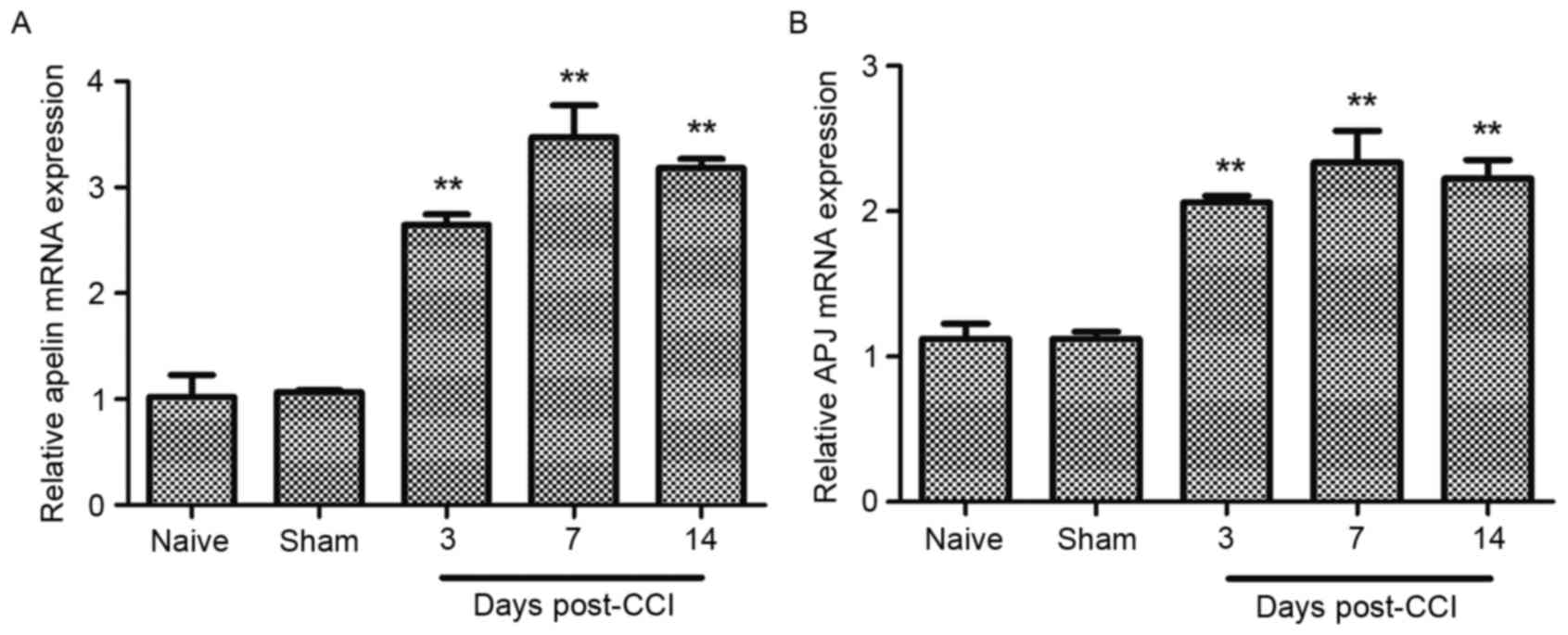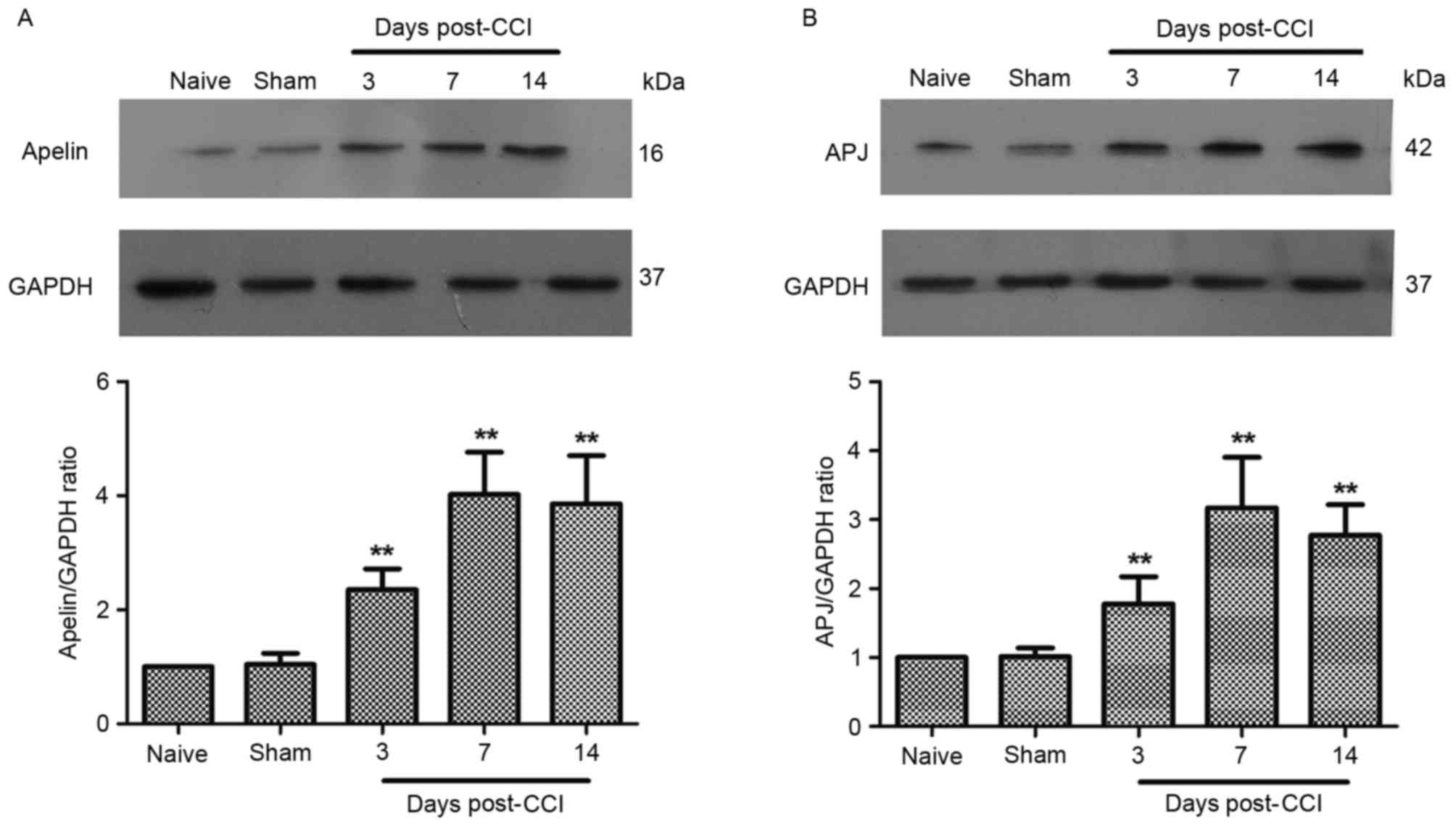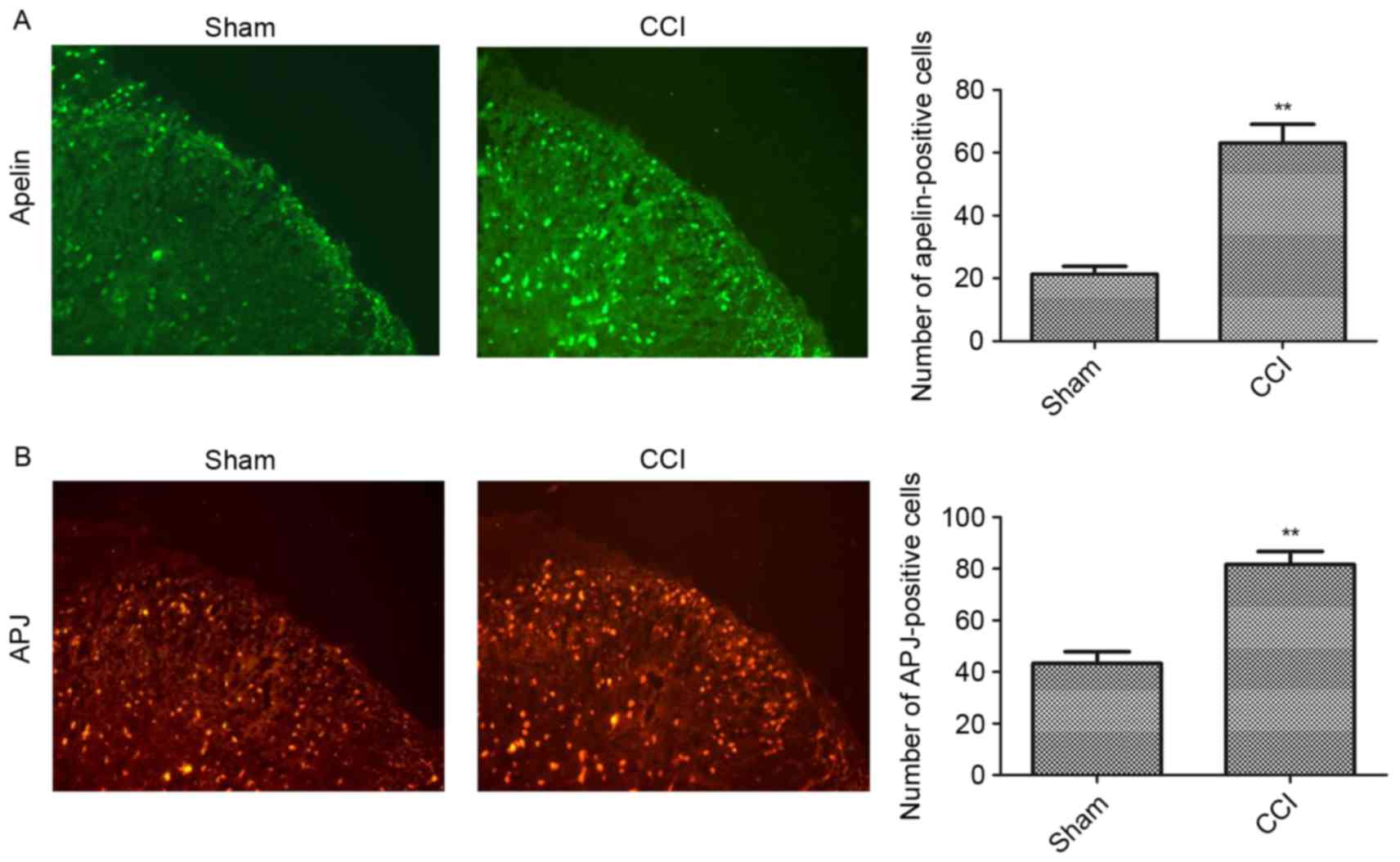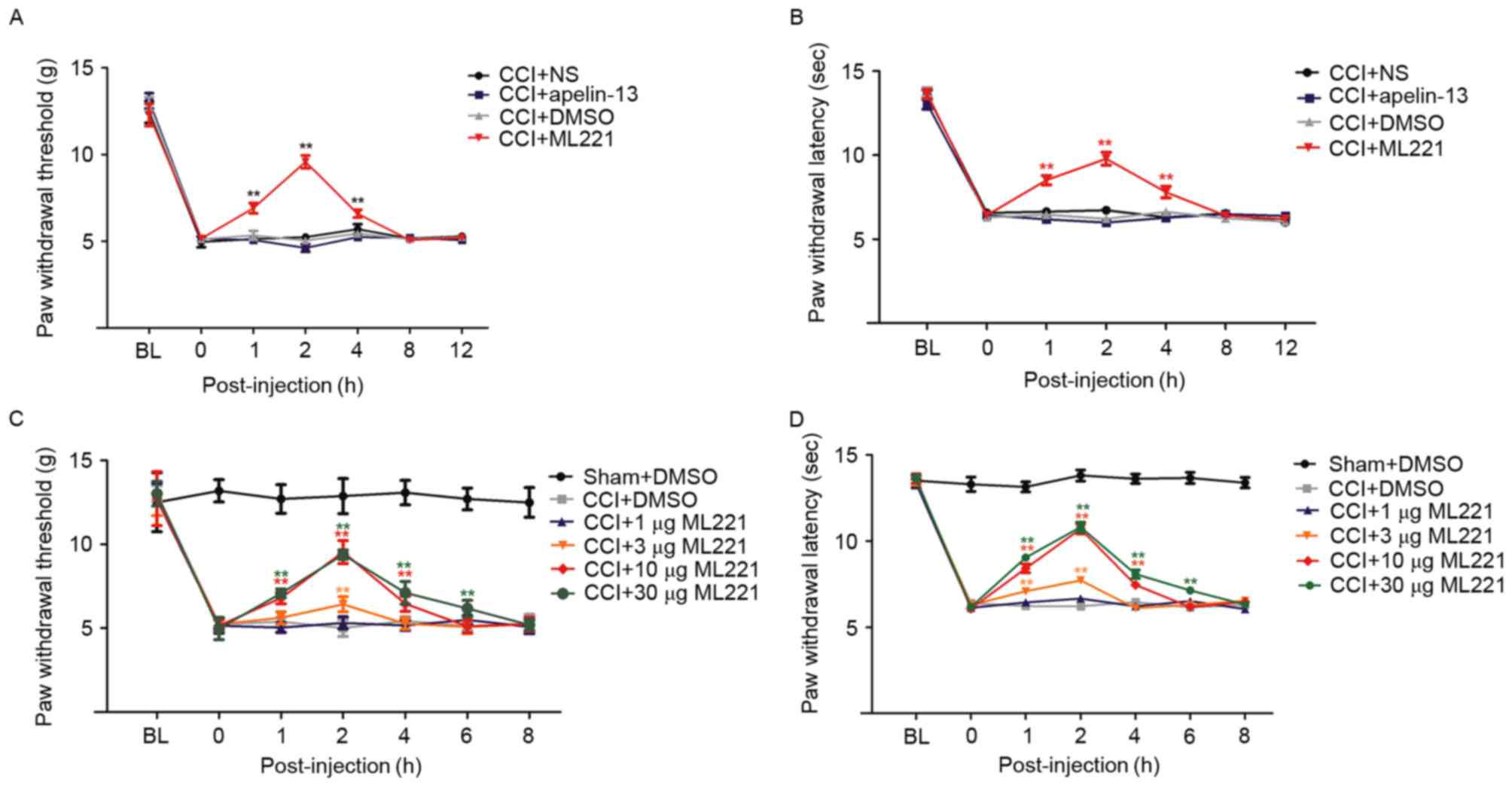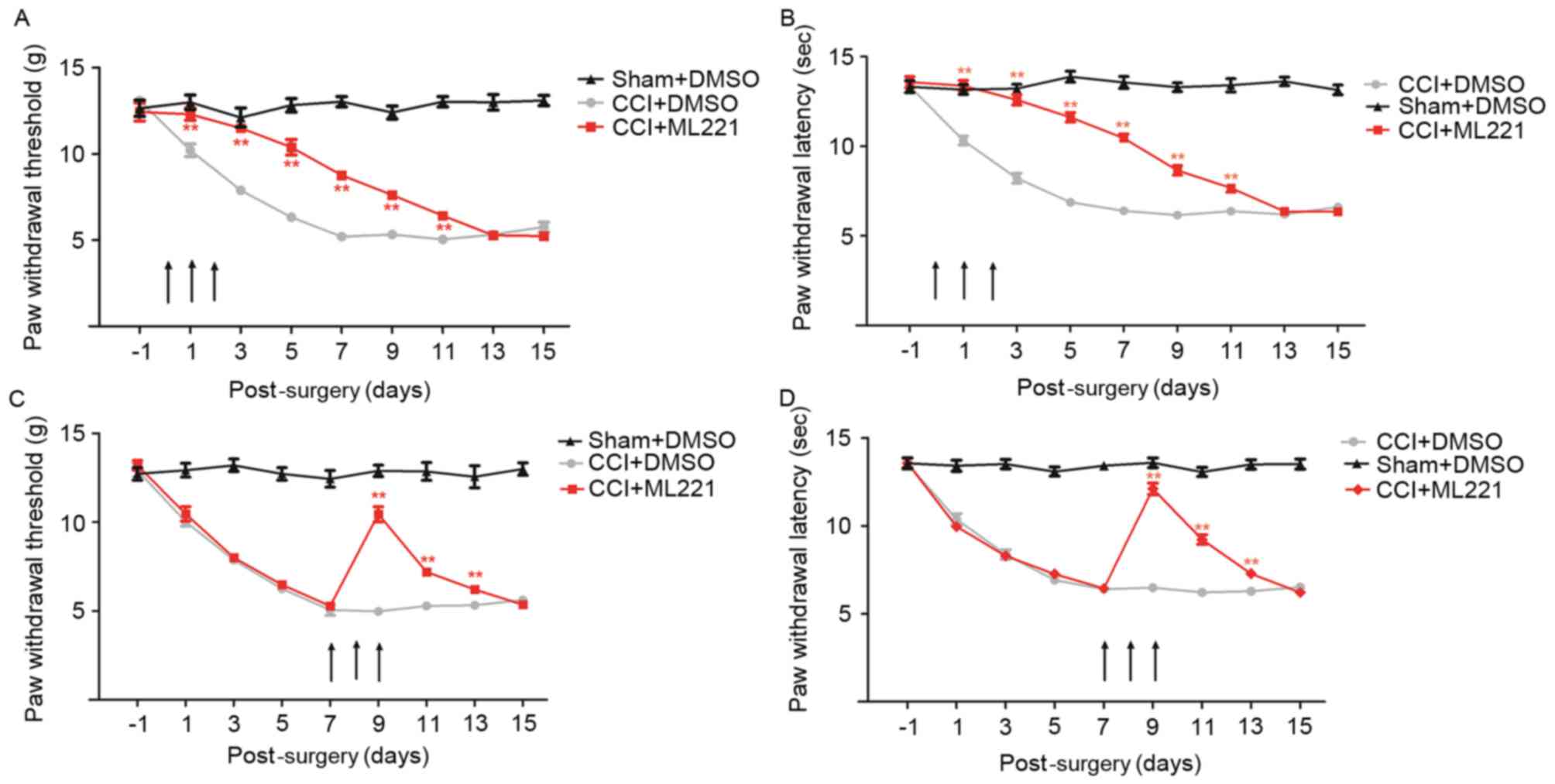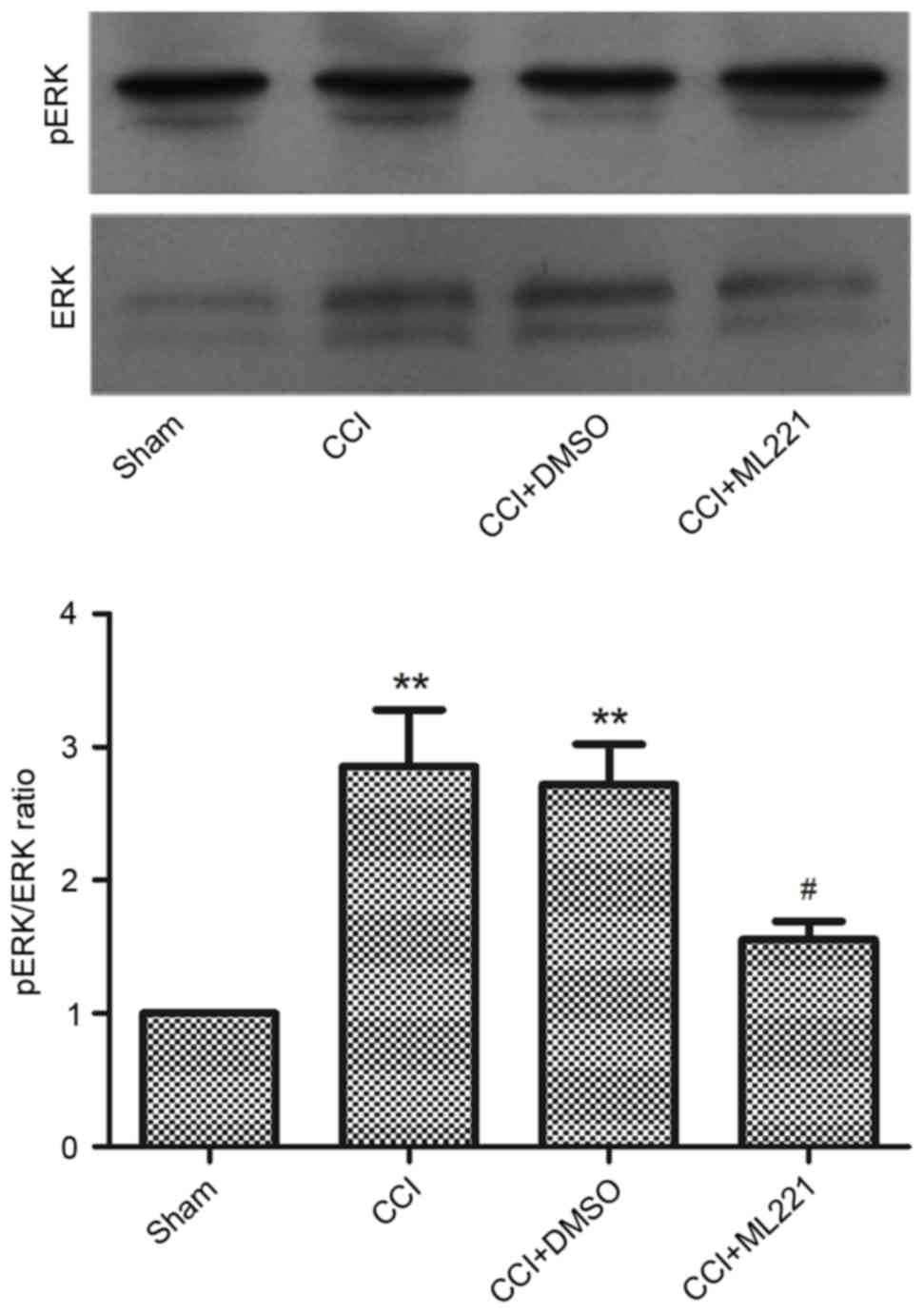|
1
|
O'Dowd BF, Heiber M, Chan A, Heng HH, Tsui
LC, Kennedy JL, Shi X, Petronis A, George SR and Nguyen T: A human
gene that shows identity with the gene encoding the angiotensin
receptor is located on chromosome 11. Gene. 136:355–360. 1993.
View Article : Google Scholar : PubMed/NCBI
|
|
2
|
Tatemoto K, Hosoya M, Habata Y, Fujii R,
Kakegawa T, Zou MX, Kawamata Y, Fukusumi S, Hinuma S, Kitada C, et
al: Isolation and characterization of a novel endogenous peptide
ligand for the human APJ receptor. Biochem Biophys Res Commun.
251:471–476. 1998. View Article : Google Scholar : PubMed/NCBI
|
|
3
|
Kawamata Y, Habata Y, Fukusumi S, Hosoya
M, Fujii R, Hinuma S, Nishizawa N, Kitada C, Onda H, Nishimura O
and Fujino M: Molecular properties of apelin: Tissue distribution
and receptor binding. Biochim Biophys Acta. 1538:162–171. 2001.
View Article : Google Scholar : PubMed/NCBI
|
|
4
|
Hosoya M, Kawamata Y, Fukusumi S, Fujii R,
Habata Y, Hinuma S, Kitada C, Honda S, Kurokawa T, Onda H, et al:
Molecular and functional characteristics of APJ. Tissue
distribution of mRNA and interaction with the endogenous ligand
apelin. J Biol Chem. 275:21061–21067. 2000. View Article : Google Scholar : PubMed/NCBI
|
|
5
|
Lee HJ, Tomioka M, Takaki Y, Masumoto H
and Saido TC: Molecular cloning and expression of aminopeptidase A
isoforms from rat hippocampus. Biochim Biophys Acta. 1493:273–278.
2000. View Article : Google Scholar : PubMed/NCBI
|
|
6
|
Japp AG and Newby DE: The apelin-APJ
system in heart failure: Pathophysiologic relevance and therapeutic
potential. Biochem Pharmacol. 75:1882–1892. 2008. View Article : Google Scholar : PubMed/NCBI
|
|
7
|
Chandrasekaran B, Dar O and McDonagh T:
The role of apelin in cardiovascular function and heart failure.
Eur J Heart Fail. 10:725–732. 2008. View Article : Google Scholar : PubMed/NCBI
|
|
8
|
Quazi R, Palaniswamy C and Frishman WH:
The emerging role of apelin in cardiovascular disease and health.
Cardiol Rev. 17:283–286. 2009. View Article : Google Scholar : PubMed/NCBI
|
|
9
|
Brown CH, Ruan M, Scott V, Tobin VA and
Ludwig M: Multi-factorial somato-dendritic regulation of phasic
spike discharge in vasopressin neurons. Prog Brain Res.
170:219–228. 2008. View Article : Google Scholar : PubMed/NCBI
|
|
10
|
Llorens-Cortes C and Moos F: Opposite
potentiality of hypothalamic coexpressed neuropeptides, apelin and
vasopressin in maintaining body-fluid homeostasis. Prog Brain Res.
170:559–570. 2008. View Article : Google Scholar : PubMed/NCBI
|
|
11
|
Rayalam S, Della-Fera MA, Krieg PA, Cox
CM, Robins A and Baile CA: A putative role for apelin in the
etiology of obesity. Biochem Biophys Res Commun. 368:815–819. 2008.
View Article : Google Scholar : PubMed/NCBI
|
|
12
|
Lee DK, George SR and O'Dowd BF:
Unravelling the roles of the apelin system: Prospective therapeutic
applications in heart failure and obesity. Trends Pharmacol Sci.
27:190–194. 2006. View Article : Google Scholar : PubMed/NCBI
|
|
13
|
Horiuchi Y, Fujii T, Kamimura Y and
Kawashima K: The endogenous, immunologically active peptide apelin
inhibits lymphocytic cholinergic activity during immunological
responses. J Neuroimmunol. 144:46–52. 2003. View Article : Google Scholar : PubMed/NCBI
|
|
14
|
Cheng B, Chen J, Bai B and Xin Q:
Neuroprotection of apelin and its signaling pathway. Peptides.
37:171–173. 2012. View Article : Google Scholar : PubMed/NCBI
|
|
15
|
Medhurst AD, Jennings CA, Robbins MJ,
Davis RP, Ellis C, Winborn KY, Lawrie KW, Hervieu G, Riley G,
Bolaky JE, et al: Pharmacological and immunohistochemical
characterization of the APJ receptor and its endogenous ligand
apelin. J Neurochem. 84:1162–1172. 2003. View Article : Google Scholar : PubMed/NCBI
|
|
16
|
Reaux A, de Mota N, Skultetyova I, Lenkei
Z, El Messari S, Gallatz K, Corvol P, Palkovits M and
Llorens-Cortes C: Physiological role of a novel neuropeptide,
apelin, and its receptor in the rat brain. J Neurochem.
77:1085–1096. 2001. View Article : Google Scholar : PubMed/NCBI
|
|
17
|
Xu N, Wang H, Fan L and Chen Q:
Supraspinal administration of apelin-13 induces antinociception via
the opioid receptor in mice. Peptides. 30:1153–1157. 2009.
View Article : Google Scholar : PubMed/NCBI
|
|
18
|
Lv SY, Qin YJ, Wang NB, Yang YJ and Chen
Q: Supraspinal antinociceptive effect of apelin-13 in a mouse
visceral pain model. Peptides. 37:165–170. 2012. View Article : Google Scholar : PubMed/NCBI
|
|
19
|
Reaux A, Gallatz K, Palkovits M and
Llorens-Cortes C: Distribution of apelin-synthesizing neurons in
the adult rat brain. Neuroscience. 113:653–662. 2002. View Article : Google Scholar : PubMed/NCBI
|
|
20
|
Lv S, Yang YJ, Hong S, Wang N, Qin Y, Li W
and Chen Q: Intrathecal apelin-13 produced different actions in
formalin test and tail-flick test in mice. Protein Pept Lett.
20:926–931. 2013. View Article : Google Scholar : PubMed/NCBI
|
|
21
|
Smith TP, Schlenz AM, Schatz JC, Maitra R
and Sweitzer SM: Modulation of pain in pediatric sickle cell
disease: Understanding the balance between endothelin mediated
vasoconstriction and apelin mediated vasodilation. Blood Cells Mol
Dis. 54:155–159. 2015. View Article : Google Scholar : PubMed/NCBI
|
|
22
|
Cui RR, Mao DA, Yi L, Wang C, Zhang XX,
Xie H, Wu XP, Liao XB, Zhou H, Meng JC, et al: Apelin suppresses
apoptosis of human vascular smooth muscle cells via APJ/PI3-K/Akt
signaling pathways. Amino Acids. 39:1193–1200. 2010. View Article : Google Scholar : PubMed/NCBI
|
|
23
|
Than A, Cheng Y, Foh LC, Leow MK, Lim SC,
Chuah YJ, Kang Y and Chen P: Apelin inhibits adipogenesis and
lipolysis through distinct molecular pathways. Mol Cell Endocrinol.
362:227–241. 2012. View Article : Google Scholar : PubMed/NCBI
|
|
24
|
Perjes A, Skoumal R, Tenhunen O, Kónyi A,
Simon M, Horváth IG, Kerkelä R, Ruskoaho H and Szokodi I: Apelin
increases cardiac contractility via protein kinase Cε- and
extracellular signal-regulated kinase-dependent mechanisms. PLoS
One. 9:e934732014. View Article : Google Scholar : PubMed/NCBI
|
|
25
|
Zimmermann M: Ethical guidelines for
investigations of experimental pain in conscious animals. Pain.
16:109–110. 1983. View Article : Google Scholar : PubMed/NCBI
|
|
26
|
Bennett GJ and Xie YK: A peripheral
mononeuropathy in rat that produces disorders of pain sensation
like those seen in man. Pain. 33:87–107. 1988. View Article : Google Scholar : PubMed/NCBI
|
|
27
|
Mestre C, Pélissier T, Fialip J, Wilcox G
and Eschalier A: A method to perform direct transcutaneous
intrathecal injection in rats. J Pharmacol Toxicol Methods.
32:197–200. 1994. View Article : Google Scholar : PubMed/NCBI
|
|
28
|
Chaplan SR, Bach FW, Pogrel JW, Chung JM
and Yaksh TL: Quantitative assessment of tactile allodynia in the
rat paw. J Neurosci Methods. 53:55–63. 1994. View Article : Google Scholar : PubMed/NCBI
|
|
29
|
Dixon WJ: Efficient analysis of
experimental observations. Annu Rev Pharmacol Toxicol. 20:441–462.
1980. View Article : Google Scholar : PubMed/NCBI
|
|
30
|
Yang JX, Hua L, Li YQ, Jiang YY, Han D,
Liu H, Tang QQ, Yang XN, Yin C, Hao LY, et al: Caveolin-1 in the
anterior cingulate cortex modulates chronic neuropathic pain via
regulation of NMDA receptor 2B subunit. J Neurosci. 35:36–52. 2015.
View Article : Google Scholar : PubMed/NCBI
|
|
31
|
Livak KJ and Schmittgen TD: Analysis of
relative gene expression data using real-time quantitative PCR and
the 2(Delta Delta C(T)) method. Methods. 25:402–408. 2001.
View Article : Google Scholar : PubMed/NCBI
|
|
32
|
Zhang X, Peng X, Fang M, Zhou C, Zhao F,
Zhang Y, Xu Y, Zhu Q, Luo J, Chen G and Wang X: Up-regulation of
apelin in brain tissue of patients with epilepsy and an epileptic
rat model. Peptides. 32:1793–1799. 2011. View Article : Google Scholar : PubMed/NCBI
|
|
33
|
Kasai A, Kinjo T, Ishihara R, Sakai I,
Ishimaru Y, Yoshioka Y, Yamamuro A, Ishige K, Ito Y and Maeda S:
Apelin deficiency accelerates the progression of amyotrophic
lateral sclerosis. PloS One. 6:e239682011. View Article : Google Scholar : PubMed/NCBI
|
|
34
|
Daviaud D, Boucher J, Gesta S, Dray C,
Guigne C, Quilliot D, Ayav A, Ziegler O, Carpene C, Saulnier-Blache
JS, et al: TNFalpha up-regulates apelin expression in human and
mouse adipose tissue. FASEB J. 20:1528–1530. 2006. View Article : Google Scholar : PubMed/NCBI
|
|
35
|
Han S, Wang G, Qi X, Englander EW and
Greeley GH Jr: Involvement of a Stat3 binding site in
inflammation-induced enteric apelin expression. Am J Physiol
Gastrointest Liver Physiol. 295:G1068–G1078. 2008. View Article : Google Scholar : PubMed/NCBI
|
|
36
|
Malyszko J, Malyszko JS, Pawlak K,
Wolczynski S and Mysliwiec M: Apelin, a novel adipocytokine, in
relation to endothelial function and inflammation in kidney
allograft recipients. Transplant Proc. 40:3466–3469. 2008.
View Article : Google Scholar : PubMed/NCBI
|
|
37
|
Boucher J, Masri B, Daviaud D, Gesta S,
Guigné C, Mazzucotelli A, Castan-Laurell I, Tack I, Knibiehler B,
Carpéné C, et al: Apelin, a newly identified adipokine up-regulated
by insulin and obesity. Endocrinology. 146:1764–1771. 2005.
View Article : Google Scholar : PubMed/NCBI
|
|
38
|
Choe W, Albright A, Sulcove J, Jaffer S,
Hesselgesser J, Lavi E, Crino P and Kolson DL: Functional
expression of the seven-transmembrane HIV-1 co-receptor APJ in
neural cells. J Neurovirol. 6 Suppl 1:S61–S69. 2000.PubMed/NCBI
|
|
39
|
O'Carroll AM, Selby TL, Palkovits M and
Lolait SJ: Distribution of mRNA encoding B78/apj, the rat homologue
of the human APJ receptor, and its endogenous ligand apelin in
brain and peripheral tissues. Biochim Biophys Acta. 1492:72–80.
2000. View Article : Google Scholar : PubMed/NCBI
|
|
40
|
Brailoiu GC, Dun SL, Yang J, Ohsawa M,
Chang JK and Dun NJ: Apelin-immunoreactivity in the rat
hypothalamus and pituitary. Neurosci Lett. 327:193–197. 2002.
View Article : Google Scholar : PubMed/NCBI
|
|
41
|
de Mota N, Lenkei Z and Llorens-Cortès C:
Cloning, pharmacological characterization and brain distribution of
the rat apelin receptor. Neuroendocrinology. 72:400–407. 2000.
View Article : Google Scholar : PubMed/NCBI
|
|
42
|
Lee DK, Cheng R, Nguyen T, Fan T,
Kariyawasam AP, Liu Y, Osmond DH, George SR and O'Dowd BF:
Characterization of apelin, the ligand for the APJ receptor. J
Neurochem. 74:34–41. 2000. View Article : Google Scholar : PubMed/NCBI
|
|
43
|
Maloney PR, Khan P, Hedrick M, Gosalia P,
Milewski M, Li L, Roth GP, Sergienko E, Suyama E, Sugarman E, et
al: Discovery of 4-oxo-6-((pyrimidin-2-ylthio)methyl)-4H-pyran-3-yl
4-nitrobenzoate (ML221) as a functional antagonist of the apelin
(APJ) receptor. Bioorg Med Chem Lett. 22:6656–6660. 2012.
View Article : Google Scholar : PubMed/NCBI
|
|
44
|
Befort K, Filliol D, Darcq E, Ghate A,
Matifas A, Lardenois A, Muller J, Thibault C, Dembele D, Poch O and
Kieffer BL: Gene expression is altered in the lateral hypothalamus
upon activation of the mu opioid receptor. Ann N Y Acad Sci.
1129:175–184. 2008. View Article : Google Scholar : PubMed/NCBI
|
|
45
|
Yang YJ, Lv SY, Xiu MH, Xu N and Chen Q:
Intracerebroventricular administration of apelin-13 inhibits distal
colonic transit in mice. Peptides. 31:2241–2246. 2010. View Article : Google Scholar : PubMed/NCBI
|
|
46
|
Lutfy K, Eitan S, Bryant CD, Yang YC,
Saliminejad N, Walwyn W, Kieffer BL, Takeshima H, Carroll FI,
Maidment NT and Evans CJ: Buprenorphine-induced antinociception is
mediated by mu-opioid receptors and compromised by concomitant
activation of opioid receptor-like receptors. J Neurosci.
23:10331–10337. 2003.PubMed/NCBI
|
|
47
|
Habata Y, Fujii R, Hosoya M, Fukusumi S,
Kawamata Y, Hinuma S, Kitada C, Nishizawa N, Murosaki S, Kurokawa
T, et al: Apelin, the natural ligand of the orphan receptor APJ, is
abundantly secreted in the colostrum. Biochim Biophys Acta.
1452:25–35. 1999. View Article : Google Scholar : PubMed/NCBI
|
|
48
|
Masri B, Lahlou H, Mazarguil H, Knibiehler
B and Audigier Y: Apelin (65–77) activates extracellular
signal-regulated kinases via a PTX-sensitive G protein. Biochem
Biophys Res Commun. 290:539–545. 2002. View Article : Google Scholar : PubMed/NCBI
|
|
49
|
Masri B, Morin N, Pedebernade L,
Knibiehler B and Audigier Y: The apelin receptor is coupled to Gi1
or Gi2 protein and is differentially desensitized by apelin
fragments. J Biol Chem. 281:18317–18326. 2006. View Article : Google Scholar : PubMed/NCBI
|
|
50
|
O'Donnell LA, Agrawal A, Sabnekar P,
Dichter MA, Lynch DR and Kolson DL: Apelin, an endogenous neuronal
peptide, protects hippocampal neurons against excitotoxic injury. J
Neurochem. 102:1905–1917. 2007. View Article : Google Scholar : PubMed/NCBI
|
|
51
|
Bai B, Tang J, Liu H, Chen J, Li Y and
Song W: Apelin-13 induces ERK1/2 but not p38 MAPK activation
through coupling of the human apelin receptor to the Gi2 pathway.
Acta Biochim Biophys Sin (Shanghai). 40:311–318. 2008. View Article : Google Scholar : PubMed/NCBI
|
|
52
|
Ji RR, Gereau RW IV, Malcangio M and
Strichartz GR: MAP kinase and pain. Brain Res Rev. 60:135–148.
2009. View Article : Google Scholar : PubMed/NCBI
|















